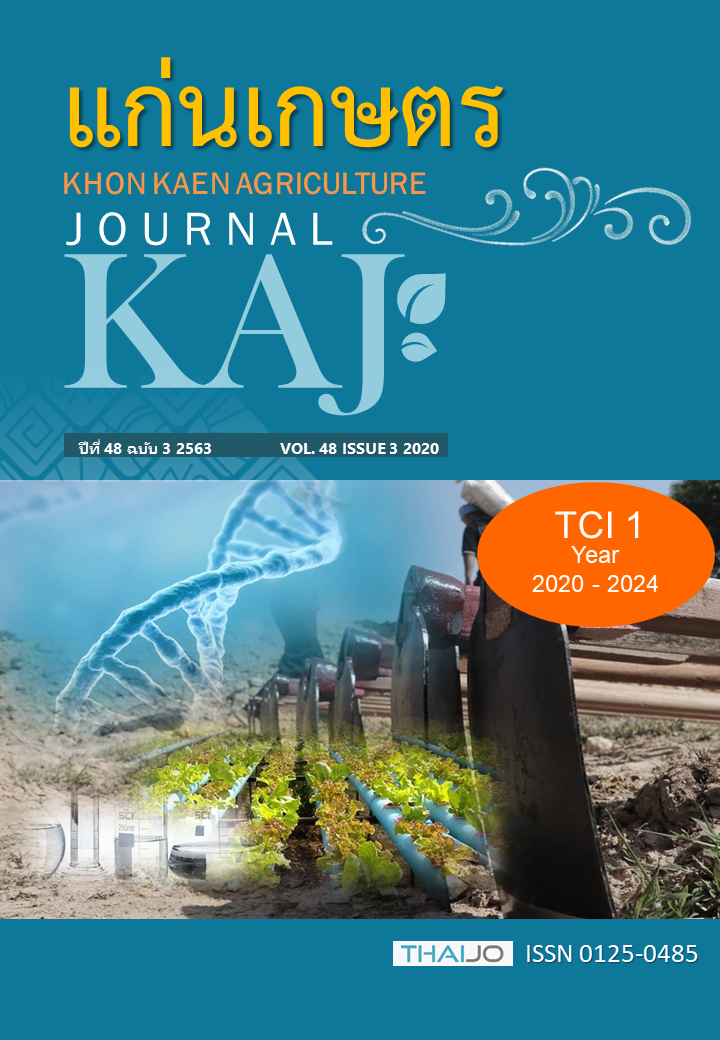ผลของความเป็นกรด-ด่างของดิน และปุ๋ยไนโตรเจนต่อปริมาณแอนโทไซยานินในเมล็ดของข้าวสีดำ
Main Article Content
บทคัดย่อ
สารแอนโทไซยานินเป็นหนึ่งในสารกลุ่มฟลาโวนอยด์ ที่ให้สารสีแดง ถึงสีม่วง ที่สามารถพบได้ในผลไม้ ผัก รวมทั้งในข้าวที่มีเมล็ดสีดำหรือแดง การสะสมของสารแอนโทไซยานินได้รับอิทธิพลจากสภาพแวดล้อมหลายปัจจัย ดังนั้นการเพิ่มปริมาณสารแอนโทไซยานินในข้าวจึงจำเป็นต้องทราบปัจจัยที่มีผลต่อการสะสมสารแอนโทไซยานินเหล่านั้น การศึกษานี้จึงได้ทำการประเมินผลของค่าความเป็นกรด-ด่างของดิน และปุ๋ยไนโตรเจนที่แตกต่างกัน ที่มีผลต่อปริมาณสารแอนโทไซยานินในเมล็ดข้าวสีดำจำนวน 4 สายพันธุ์ ทดสอบในจังหวัดสกลนครและขอนแก่น พบว่า ค่าความเป็นกรด-ด่างของดินมีผลต่อปริมาณสารแอนโทไซยานินในข้าวแต่ละสายพันธุ์ที่แตกต่างกันที่ปลูกจังหวัดสกลนคร ความเป็นกรด-ด่างของดิน และปุ๋ยไนโตรเจนมีผลโดยตรงต่อน้ำหนักแห้งต้น พื้นที่ใบ จำนวนหน่อต่อกอ และจำนวนรวงต่อกอในทั้งสองจังหวัด นอกจากนั้นยังพบว่า ปริมาณสารแอนโทไซยานินแตกต่างกันไปขึ้นอยู่กับสถานที่และพันธุ์ของข้าวด้วย โดยข้าวพันธุ์ ULR238 มีปริมาณแอนโทไซยานินสูงที่สุด ระดับของความเป็นกรด-ด่างของดินและปุ๋ยไนตรเจนที่เหมาะสมจะเป็นประโยชน์ในการผลิตข้าวให้ได้คุณภาพต่อไป
Article Details
เอกสารอ้างอิง
Chunthaburee, S., S. Sakuanrungsirikul, T. Wongwarat, J. Sanitchon, W. Pattanagul, and P. Theerakulpisut, 2016. Changes in anthocyanin content and expression of anthocyanin synthesis genes in seedlings of black glutinous rice in response to salt stress. Asian J. Plant Sci. 15: 56-65.
Deepa, G., V. Singh, and K.A. Naidu, 2008. Nutrient composition and physicochemical properties of Indian medicinal rice: Najavara. Food Chem. 106: 165–171.
Diaz, C., V. Saliba-Colombani, O. Loudet, P. Belluomo, L. Moreau, F. Daniel-Vedele, J. Morot-Gaudry, and C. Masclaux-Daubresse. 2006. Leaf yellowing and anthocyanin accumulation are two genetically independent strategies in response to nitrogen limitation in Arabidopsis thaliana. Plant Cell Physiol. 47: 74–83.
Dilip, G. and K. Tetsuya. 2007. Anthocyanins and anthocyanin-rich extracts: Role in diabetes and eye function. Asia. Pac. J. Clin. Nutr. 16: 200-208.
Fageria, N.K., E.M. Castro, and V.C. Baligar. 2004. Response of upland rice genotypes to soil acidity. In The Red Soils of China, Wilson, M.J., He, Z., Yang, X., Eds.; Springer: Dordrecht, pp. 219-237.
Garcia, D.M., P.Z. Bassinello, D.R.P. Ascheri, J.L.R. Ascheri, J.B. Trovo, and R.M.A. Cobucci. 2010. Cooking quality of upland and lowland rice characterized by different methods. Ciencia. Tecnol. Alime. 31: 341-348.
Gomez, K.A., and A.A. Gomez. 1984. Statistical procedures for agricultural research, 3rd ed.; John Wiley and Sons: New York: USA, pp. 7-170.
Goufo, P., and H. Trindade. 2014. Rice antioxidants: phenolic acids, flavonoids, anthocyanins, proanthocyanidins, tocopherols, tocotrienols, γ-oryzanol, and phytic acid. Food Sci. Nutri. 2: 75–104.
Harukaze, A., M. Murata, and S. Homma. 1999. Analysis of free and bound phenolics in rice. Food Sci Technol Res. 5: 74–79.
Hiratsuka, S., H. Onodera, Y. Kawai, T. Kubo H. Itoh, and R. Wada. 2001. ABA and sugar effects on anthocyanin formation in grape berry cultured in vitro. Sci. Hortic. 90: 121– 130.
Iqbal, S., M.I. Bhanger, and F. Anwar. 2005. Antioxidant properties and components of some commercially available varieties of rice bran in Pakistan. Food Chem. 93: 265–272.
Jugsujinda, A., and J. W.H. Patrick. 1976. Growth and nutrient uptake by rice in a flooded soil under controlled aerobic-anaerobic and pH conditions. Agron. J. 69: 705-710.
Kang, M.S. 1998. Using genotype-by-environment interactions for crop cultivar development. Adv. Agron.62: 201-210.
Khush, G.S., and R.S Virk. 2000. Rice breeding: achievements and future strategies. J. Crop Improv. 27: 115-144.
Knievel, D.C., E.S.M. Abdel Aal, I. Rabalski, T. Nakamura, and P. Hucl. 2009. Grain color development and the inheritance of high anthocyanin blue aleurone and purple pericarp in spring wheat (Triticum aestivum L.). J. Cereal Sci. 50: 113-120.
Kumi, Y., T.K. Yuki, K. Kiyoshi, and K. Tadao. 2003. Sepal color variation of hydrangea macrophylla and vacuolar pH measured with a proton-selective microelectrode. Plant Cell Physiol. 44: 262-268.
Lanceras, J.C., Z.L. Huang, O. Naivikul, A. Vanavichit, V. Ruanjaichon, and S. Tragoonrun. 2000. Mapping of genes for cooking and eating qualities in Thai Jasmine rice (KDML 105). DNA Res. 7: 93–101.
Markus, K., and H. Geza. 1998. Interaction of nitrogen availity during bllom and light intensity during veraison. II. Effects on anthocyanin and phenolic development during grape ripening. Am. J. Enol Vitic.49: 341-349.
Melini, V., and R. Acquistucci. 2017. Health-promoting compounds in pigmented Thai and wild rice. Foods 6: 2-13.
Muhidin J. K., S. Elkawakib, M. Yunus, M. Kaimuddin, S.G. Ray, and B.L. Rianda. 2013. The development of upland red rice under shade trees. World Appl. Sci. J. 24: 23-30.
Peng, S., F.V. Garcia, R.C. Laza, A.L. Sanico, R.M. Visperas, and K.G. Cassman. 1996. Increased N-use efficiency using a chlorophyll meter on high-yielding irrigated rice. Field Crops Res. 47: 243-252.
Rerkasem, B., S. Jumrus, N. Yimyam, and C. Prom-u-thai. 2015. Variation of grain nutritional quality among Thai purple rice genotypes grown at two different altitudes. Science Asia 41: 377–385.
Rogers, E.J., S.M. Rice, R.J. Nicolosi, D.R. Carpenter, C.A. McClelland, and J.L.J. Romanczyk. 1993. Identification and quantitation of c-oryzanol components and simultaneous assessment of tocols in rice bran oil. J. Am. Oil. Chem. Soc. 70: 301–307.
Ryu, S.N., S.Z. Park, S.S. Kang, and S.J. Han. 2003. Determination of C3G content in black purple rice using HPLC and UV-Vis spectrophotometer. Korean J. Crop Sci. 48: 369-371.
Somsana, P., P. Wattana, B. Suriharn, and J. Sanitchon. 2013. Stability and genotype by environment interactions for grain anthocyanin content of Thai black glutinous upland rice (Oryza sativa). SABRAO J. Breed. Genet. 45: 523-532.
Soubeyrand, E., C. Basteau, G. Hilbert, C. van Leeuwen, S. Delrot, and E. Gomès. 2014. Nitrogen supply affects anthocyanin biosynthetic and regulatory genes in grapevine cv, Cabernet–Sauvignon berries. Phytochem. 103: 38-49.
Tanaka, Y., N. Sasaki, and A. Ohmiya. 2008. Biosynthesis of plant pigments: anthocyanins, betalains and carotenoids. Plant J. 3: 207-219.
Terahara, N., N. Saigusa, R. Ohba, and S. Ued., 1994. Composition of anthocyanin pigments in aromatic red rice and its wine. Japan Soc. Food Sci. Technol. 41: 519–522.


